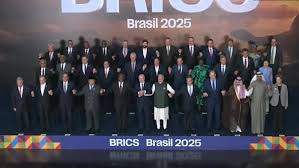As Trump warns BRICS, China, Russia say group doesn’t target anyone

As global tensions over trade and geopolitics intensify, former U.S. President Donald Trump has launched a sharp warning at the BRICS alliance, calling it “anti-American” and threatening steep tariffs on countries aligning with the bloc. However, key BRICS members, particularly China and Russia, have pushed back, clarifying that the group is not aimed at confronting or isolating the United States.
Trump’s Bold Message to BRICS
On Sunday, Donald Trump, the presumptive Republican nominee for the 2024 U.S. Presidential election, took to his Truth Social platform with a stern message. “Any country aligning themselves with the anti-American policies of BRICS will be charged an additional 10% tariff, with no exceptions,” he wrote. The message echoed his previous hardline trade stance during his time in office, which often included tariffs on China, Canada, Mexico, and the European Union.
Trump accused BRICS of encouraging de-dollarization and undermining U.S. interests, describing the group as “a direct challenge to American leadership.” He claimed that BRICS policies promote economic protectionism and give space for authoritarian regimes to gain global influence.
This warning comes at a time when BRICS—originally formed by Brazil, Russia, India, China, and South Africa—has expanded its influence and attracted new interest from developing economies. Argentina, Iran, Egypt, Ethiopia, and the United Arab Emirates have either formally joined or expressed interest in the bloc, signaling a shift in the global economic landscape.
China and Russia: “We Are Not Targeting Anyone”
In response to Trump’s rhetoric, Chinese Foreign Ministry spokesperson Lin Jian clarified Beijing’s position. “BRICS is a platform for cooperation among emerging markets and developing countries,” he said during a press briefing. “It does not target any third party. Our purpose is not confrontation but coordination.”
Russia’s Deputy Foreign Minister Sergey Ryabkov echoed similar sentiments. “Our participation in BRICS is about promoting a multipolar world order where every nation’s voice matters. We have never sought to oppose the United States or any other country directly,” he said.
Both nations emphasized that BRICS serves as a multilateral partnership aimed at enhancing trade, development, and diplomacy among member states. According to them, it is not a military alliance or a political front against the West.
BRICS Pushes Back on “Anti-American” Label
During the recent BRICS summit in Rio de Janeiro, member states took a diplomatic but firm stand against Trump’s assertion. South African President Cyril Ramaphosa stated, “BRICS is not a club of confrontation. We are here to build partnerships, not enmities.”
Brazilian President Luiz Inácio Lula da Silva added, “The world does not want an emperor. It wants cooperation, alternatives, and respect for sovereignty.” While Lula reiterated the bloc’s desire to reduce dependence on the U.S. dollar in international trade, he maintained that it was not an attack on the dollar itself but a call for financial multipolarity.
Even India, which has had historically complex relations with both China and the U.S., avoided any anti-American messaging. A statement from the Indian Ministry of External Affairs emphasized that “India views BRICS as a tool for positive global engagement.”
The Bigger Picture: A Changing Global Order
While Trump’s warning was directed at BRICS, it reflects broader anxieties within Washington over the shifting global economic and political balance. The BRICS bloc now represents over 40% of the world’s population and roughly 30% of global GDP. Its growing weight has raised questions about the continued dominance of U.S.-led institutions like the International Monetary Fund and World Bank.
Moreover, the group’s push to create a unified digital payment platform and explore a BRICS currency threatens the centrality of the U.S. dollar in global trade. Some experts argue this is a necessary step toward global financial democratization, while others see it as an open challenge to U.S. influence.
“Whether or not BRICS is intentionally anti-U.S., its very formation and expansion reflect frustration with the existing global order,” says Ananya Rajan, a geopolitical analyst at the Observer Institute. “Trump is tapping into a real concern among U.S. industries and policymakers.”
Allies Caught in the Middle
Trump’s tariff warning has also placed traditional U.S. allies like South Africa and Brazil in a difficult position. These nations depend heavily on trade with both the U.S. and China, and any new tariff regime could disrupt their economies. Economists warn that if the U.S. follows through on these threats, retaliatory measures could follow, further straining global supply chains.
Additionally, emerging markets watching the BRICS development may feel pressured to choose sides. However, BRICS leaders seem unified in their effort to present the alliance as inclusive rather than exclusive.
“We invite cooperation, not conflict,” said South African Foreign Minister Naledi Pandor. “We don’t want to be told we have to pick one side over another.”
What’s Next?
As the U.S. presidential election draws closer and Trump’s rhetoric intensifies, BRICS countries are likely to continue positioning themselves as neutral, pragmatic actors in a multipolar world. But the lines between economic partnership and political alignment may continue to blur.
A potential Trump victory in November could reignite tariff wars and further disrupt multilateral diplomacy, especially if he doubles down on punishing BRICS-aligned countries. Meanwhile, current U.S. President Joe Biden has taken a more measured approach, stating that the U.S. “respects global partnerships” while defending the dollar’s role.
Only time will tell whether BRICS can maintain its image as a cooperative force or whether Trump’s warnings will reshape the group’s trajectory.






